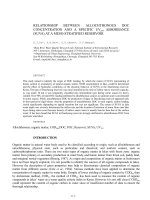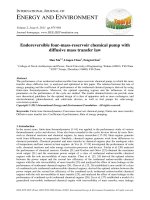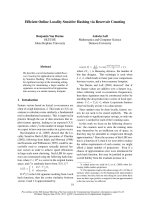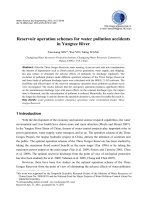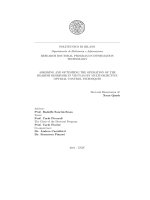reservoir sedimentation
Bạn đang xem bản rút gọn của tài liệu. Xem và tải ngay bản đầy đủ của tài liệu tại đây (7.87 MB, 233 trang )
RESERVOIR
SEDIMENTATION
DEVELOPMENTS IN WATER SCIENCE,
29
OTHER
TITLES
IN
THISSERIES
1
COMPUTER SYSTEMS AND WATER RESOURCES
G. BUGLIARELLO AND
F.
GUNTER
2
H.L. GOLTERMAN
PHYSIOLOGICAL LIMNOLOGY
3
MULTIOBJECTIVE OPTIMIZATION
IN
WATER RESOURCES SYSTEMS:
THE SURROGATE WORTH TRADE-OFF-METHOD
Y.Y. HAIMES. W.A. HALL AND H.T. FREEDMAN
4
J.J. FRIED
GROUNDWATER POLLUTION
5 N.
RAJARATNAM
TURBULENT JETS
6
D.
STEPHENSON
PIPELINE DESIGN FOR WATER ENGINEERS
GROUNDWATER HYDRAULICS
7
v.
HALEK
AND
J.
SVEC
8
J.BALEK
HYDROLOGY AND WATER RESOURCES IN TROPICAL AFRICA
9
T.A. McMAHON AND R.G. MElN
RESERVOIR CAPACITY AND YIELD
10
G.KOVACS
SEEPAGE HYDRAULICS
11
HYDRODYNAMICS OF LAKES: PROCEEDINGS
OF
A SYMPOSIUM
12-1
3
OCTOBER
1978,
LAUSANNE, SWITZERLAND
12
CONTEMPORARY HYDROGEOLOGY: THE GEORGE BURKE MAXEY MEMORIAL VOLUME
SEEPAGE AND GROUNDWATER
14
D.
STEPHENSON
STORMWATER HYDROLOGY AND DRAINAGE
15
D.
STEPHENSON
PIPELINE DESIGN FOR WATER ENGINEERS
(completely revised edition
of
Vol.
6
in the series)
SYMPOSIUM ON GEOCHEMISTRY
OF
GROUNDWATER
17
TIME SERIES METHODS
IN
HYDROSCIENCES
18
J.BALEK
HYDROLOGY AND WATER RESOURCES IN TROPICAL REGIONS
19
D.
STEPHENSON
PlPEFLOW ANALYSIS
20
I.
ZAVOIANU
MORPHOMETRY OF DRAINAGE BASINS
21
M.M.A. SHAHIN
HYDROLOGY OF THE NILE BASIN
22
H.C. RIGGS
STREAMF LOW CHARACTERISTICS
23
M.
NEGULESCU
MUNICIPAL WASTEWATER TREATMENT
24
L.G. EVERETT
GROUNDWATER MONITORING HANDBOOK FOR COAL AND OIL SHALE DEVELOPMENT
25
W. KINZELBACH
GROUNDWATER MODELLING: AN INTRODUCTION WITH SAMPLE PROGRAMS IN BASIC
26
KINEMATIC HYDROLOGY AND MODELLING
27
STATISTICAL ASPECTS OF WATER QUALITY MONITORING
-
PROCEEDINGS OF THE
WORKSHOP HELD AT THE CANADIAN CENTRE FOR INLAND WATERS, OCTOBER
1985
28
M.JERMAR
WATER RESOURCES AND WATER MANAGEMENT
W.H. GRAF AND C.H. MORTIMER (EDITORS)
W. BACK AND D.A. STEPHENSON (EDITORS)
13
M.A.
MARIEO
AND
J.N.
LUTHIN
16
w.
BACK
AND
R.
L~TOLLE
(EDITORS)
A.H. ELSHAARAWI (EDITOR) IN COLLABORATION WITH
S.R.
ESTERBY
D.
STEPHENSON AND M.E. MEADOWS
A.M. EL SHAARAWI AND R.E. KWIATKOWSKI (EDITORS)
G.W.
ANNANDALE
Rand Afrikaans University, Auckland Park Johannesburg,
P.O.
Box
524,
2000
Johannesburg, South Africa.
ELSEVIER
Amsterdam
-
Oxford
-
New
York
-
Tokyo
1
987
ELSEVIER SCIENCE PUBLISHERS B.V.
Sara Burgerhartstraat 25
P.O. Box 21 1, 1000 AE Amsterdam, The Netherlands
Distributors for the United States and Canada:
ELSEVIER SCIENCE PUBLISHING COMPANY INC
52, Vanderbilt Avenue
New York, NY 10017, USA.
ISBN 0-444-42729-5 (Vol. 29)
ISBN 0-444-41 669-2 (Series)
0
Elsevier Science Publishers B.V., 1987
All rights reserved. No part of this publication may be reproduced, stored in a retrieval system or
transmitted in any form or by any means, electronic, mechanical, photocopying, recording or
otherwise, without the prior written permission of the publisher, Elsevier Science Publishers B.V./
Science &Technology Division, P.O. Box
330,
1000 AH Amsterdam, The Netherlands.
Special regulations for readers in the USA
-
This publication has been registered
with
the Copyright
Clearance Center Inc. (CCC), Salem, Massachusetts. Information can be obtained from the CCC
about conditions under which photocopies of parts of this publication may be made in the USA. All
other copyright questions, including photocopying outside of the USA, should be referred to the
publisher.
Printed in The Netherlands
To
my
wife Nicolene
for her encouragement,
support
and hard work.
This Page Intentionally Left Blank
VII
PREFACE
Books
on
the subject of reservoir sedimentation are generally lacking.
There
is however
a
need for collecting, documenting and evaluating the knowledge
available in this field of engineering. Research on reservoir sedimentation
in recent years
was
aimed mainly
at
water resources projects in developing
countries. These countries, especially in Africa, often have to cope with
long droughts, flash floods and severe erosion problems. Large reservoir
capacities
are
required to capture water provided by flash floods
so
as
to
ensure the supply of water in periods of drought. The problem arising
however
is
that these floods, due
to
their tremendous stream power, carry
enormous volumes of sediment which, due
to
the size of reservoirs,
are
virtually deposited in toto in the reservoir basin, leading
to
fast deterio-
ration of a costly investment. Accurate forecasting of reservoir behaviour
is
therefore of the utmost importance.
The point of view taken in this book
is
that of the water resources engineer
who wishes to predict the effect of sediment deposition
on
a reservoir and
its
immediate environment. Practical procedures to estimate sediment yield,
calculate sediment profiles and assess the influence sediment retention has
on the river downstream of a reservoir are presented. Preventative measures
are also discussed.
The practical approach adopted in this book by illustrating theory with
examples should appeal
to
the design engineer. However, new theory presented
regarding processes involved in the deposition of sediment in reservoirs
should also stimulate the more academically minded research engineer
to
some
deeper thought.
This Page Intentionally Left Blank
IX
CONTENTS
Chapter
1:
PROBLEMS RELATED TO RESERVOIR SEDIMENTATION
1
Chapter
2:
OPEN CHANNEL HYDRAULICS
2.1
2.2
2.3
2.4
2.5
2.6
2.7
2.8
2.9
INTRODUCTION
4
REYNOLDS TRANSPORT THEOREM
4
CONSERVATION OF
MASS
7
CONSERVATION OF ENERGY
8
CONSERVATION OF LINEAR MOMENTUM
11
SPECIFIC ENERGY
12
UNIFORM FLOW
18
2.7.1
Flow
resistance
equations
21
2.7.2
Estimation
of
roughness
coefficients
23
2.7.3
Calculation
of
uniform
flow
36
NONUNIFORM FLOW
42
2.8.1
Hydraulic jump
42
2.8.2
Gradually
varied
flow
46
SUMMARY
63
Chapter
3:
RIVER BEHAVIOUR
3.1
INTRODUCTION
65
3.2
THE FLUVIAL SYSTEM
65
3.3
THE TRANSFER ZONE
67
3.3.1
Braided streams
67
3.3.2
Meandering
streams
68
3.4
STABILITY
75
3.5
ENGINEERING ANALYSIS
76
3.6
CONCLUSION
77
Chapter
4:
SEDIMENT TRANSPORT THEORIES
4.1
ROTTNER
(1959)
78
4.2
EINSTEIN'S BED LOAD EQUATIONS
(1942. 1950)
79
4.2.1
Einstein
(1942)
79
4.2.2
Einstein
(1950)
80
4.3
BAGNOLD
84
4.4
ENGELUND AND HANSEN
(1967)
85
4.5
LAURSEN
86
4.6
EINSTEIN'S
(1950)
TOTAL LOAD EQUATION
88
4.7
BISHOP, SIMONS AND RICHARDSON
(1965)
88
4.8
ACKERS
(1972)
AND WHITE
(1972)
89
4.9
GRAF AND ACAROGLU
(1968)
90
4.10
TOFFALETTI
(1968)
92
4.11
BLENCH
(1964)
93
4.13
YALIN
(1963)
95
4.14
STREAM POWER THEORY
96
4.15
EVALUATION
97
4.12
KALINSKE
(1947)
95
X
Chapter
5:
ESTIMATION
OF
SEDIMENT YIELD
5.1
GLOBAL SEDIMENT YIELD
99
5.2 TECHNIQUES
OF
ESTIMATION
101
5.2.1
Yield
estimation
102
5.2.2 Sediment
retention
108
5.2.3 Conclusion
116
Chapter 6: PREVENTATIVE MEASURES
6.1 CONTROLLING SEDIMENT DISCHARGE
118
6.2 CONTROLLING SEDIMENT DEPOSITION
119
6.3 REMOVAL
OF
DEPOSITED SEDIMENT
120
6.4 CONCLUSION
121
Chapter 7: DISTKIBUTION OF DEPOSITED SEDIMENT
7.1 BORLAND AND MILLER (1958)
122
7.2 MENNS AND KRIEL (1959)
129
7.3 BORLAND (1970)
129
7.4 OTHER MODELS
132
7.4.2 Analytical methods
140
7.5 CONCLUSION
146
7.4.1 Empirical models
134
Chapter
8:
STREAM POWER THEORY
8.1 STABLE NON-EQUILIBRIUM CONDITIONS
148
8.1.1
Theory
148
8.1.2 Verification
159
8.1.3
Calculation procedure: Analytical approach
164
8.1.4
Calculation
procedure: Semi-empirical approach
167
8.2 UNSTABLE NON-EQUILIBRIUM CONDITIONS
173
8.2.1 Theory
173
8.2.2 Verification
177
8.2.3 Calculation procedure: Analytical approach
180
8.2.4 Calculation procedure: Semi-empirical approach
186
8.3
CONCLUSION
190
Chapter 9: SCOUR DOWNSTREAM
OF
RESERVOIRS
9.1 INTRODUCTION
191
9.2 ARMOURING
192
9.2.1 Particle stability approach
192
9.2.2 Probability approach
196
9.3 SCOUR
201
9.3.1 Komura and Simons (1967)
202
9.3.2 Aksoy (1970)
206
9.4 CONCLUSION
211
REFERENCES
212
INDEX
220
T
Chapter
1
PROBLEMS
RELATED TO RESERVOIR SEDIMENTATION
The role of the water resources engineer in
a
counrry's economy often goes
unnoticed but
is
of vital importance, especially
in
the case of developing
and semi-arid countries. Supply of sufficient water for urban, industrial
and farming use in semi-arid countries requires large reservoirs to compen-
sate for the irregular flow
of
water.
In
capturing the excess water, often
supplied by flash floods, large volumes of sediment
are
usually deposited in
the reservoir basin.
It
is
these deposits of sediment that are of great
concern to the water resources engineer. Effective evaluation of the effects
of sediment deposits requires
a
quantitative analysis of sediment processes,
the subject
matter
of this book.
In order to appreciate the influence
of
reservoir sedimentation
on
the
environment
it
is
important to view the reservoir as part of
a
river system.
Before the existence of a reservoir, the river in which
it
is
built endeav-
ours to attain a condition of stability. Construction of a reservoir dis-
turbs the normal flow pattern however and sediment
is
deposited in the
reservoir basin, in an attempt to restore the original progress that has been
made towards stability. During this process the river geometry
is
changed
both upstream of the dam
wall,
due to deposition of sediment, and downstream,
not by an excess of sediment, but by
a
lack thereof in the water. The
"sediment hungry" water entrains sediment downstream of
a
dam
wall,
leading
to
degradation. The influences of these processes,
as
far as the
water
resources engineer
is
concerned, can be subdivided into implications for the
environment, economic life and the design of
a
reservoir.
Large reservoirs invariably have tremendous influence
on
the environment, and
engineers have in the past been accused, often justifiably, of being insensi-
tive to these issues. However, the attitude of engineers has changed in
recent years and their contribution in quantifying certain impacts of pro-
posed projects
on
the environment plays an important role in many studies.
The intention
is
not to deal with environmental issues in great detail, but
merely to present
a
few examples of the influence disturbed sediment dis-
charge in
rivers
has on the environment and to highlight the importance
of
quantitative analyses.
In
viewing processes downstream
of
reservoirs
it
is
not only the scour processes that are of importance but also the effect
reduced water and sediment\ discharge has
on
the livelihood of marshes and
floodplains.
It
is of course
not
within the field of expertise of the
engineer to investigate the influence of different flow patterns (both of
water and sediment)
on
plant and animal life, and a life science specialist
will have to be co-opted for this task. The engineer however will be respon-
sible for quantifying sediment and water discharge patterns downstream of a
reservoir, information which is required to reliably determine the potential
influence of a reservoir on the original river system.
The effect of degradation as regards
loss
of fertile soil and changes in
aquatic environment due to changes in river geometry, also require rigid
calculation procedures. In the region upstream of the reservoir sediment
deposition can, due to drastic changes in the cross-sectional geometry of
rivers, have considerable influence
on
flood lines and also result in other
environmental damage.
Anticipating the effect reservoir sedimentation will have on flood lines
upstream of reservoirs is very important, as inaccurate assessment can result
in unplanned inundation, which could lead to considerable losses of both crop
and wild plant life. Deposited sediment can also, in cases where reservoir
levels are often low, result in damage to the surrounding areas. This occurs
due to wind-blown sediment, which is entrained from the beaches surrounding
the water perimeter. These sediments can cause considerable damage to plant
life in the vicinity.
The vulnerability of the economic life of a water resources project
to
reservoir sedimentation stems from the nonlinear relationship between yield
of water and reservoir capacity. Severe reductions in yield of water from a
reservoir can result from relatively small changes in reservoir volume.
A
conflict therefore arises in areas where reservoir sedimentation is a prob-
lem, and the water resources engineer must be able to accurately forecast the
balance between decreasing yield and increasing demand for water as time
passes.
Misjudgement during the planning stages of a project can turn out to
be a considerable financial burden
on
a community or country.
The influence of sediment deposition on reservoir design affects decisions
regarding the placement
of
sluices in dam walls and estimation
of
excess
pressure due to deposited sediment on structures such as dam walls and intake
towers.
It
is therefore very important to accurately predict sediment
distribution in a reservoir. Large volumes of deposited sediment will not
necessarily mean that pressures due to sediment on a dam wall will be
3
considerable. The shape of the reservoir basin and sediment transport
characteristics may be such that most of the sediment
is
distributed in the
upstream reaches, perhaps not even reaching the dam
wall.
In
other cases
large volumes of sediment may deposit close to the
wall,
leading to forces
on
the structure that are in excess of the normal hydrostatic forces. The
influence of sediment distribution
on
the placement
of
sluices follows
a
similar
line of reasoning and further emphasizes the need for accurate
calculation procedures to forecast distribution of deposited sediment.
The material in the rest of the
book
has been organized
to
enable the water
resources engineer to quantify most of the phenomena associated with
reser-
voir sedimentation. Chapter
2
reviews basic hydraulic principles and can be
omitted by those familiar with the details. Chapter
3
deals with morpho-
logical principles of river mechanics, and the most popular sediment trans-
port theories are reviewed, compared and evaluated in Chapter
4.
Practical
techniques for estimating yield
of
sediment from catchments and retention
thereof in reservoirs
are
presented in Chapter
5.
Chapter
6
deals with
measures that can be taken
to
prevent reservoir sedimentation, and existing
techniques for forecasting the distribution of deposited sediment are pre-
sented and evaluated in Chapter
7.
Chapter
8
presents modern concepts of
processes involved in reservoir sedimentation together with four new calcula-
tion procedures, illustrated by example. Techniques for forecasting scour
downstream of reservoirs are reviewed in Chapter
9.
4
Chapter
2
OPEN
CHANNEL
HYDRAULICS
2.1
INTRODUCTION
A
study of reservoir sedimentation being part of the study of open channel
flow in movable bed channels, requires knowledge
of
the basic principles of
open channel hydraulics as well as of river behaviour. Basic principles of
open channel hydraulics
will
be dealt with in this chapter, while basic
principles of river behaviour
will
be dealt with in Chapter
3.
Relationships describing the behaviour of fluid flowing in open channels
will
be derived by using the Reynolds transport theorem
as
point of departure.
This theorem allows an understanding of the relationship between
a
system and
a control volume; the latter approach being the most popular amongst civil
engineers. Subsequent to the derivation of conservation of
mass,
linear
momentum and energy equations, the concept of specific energy
is
reviewed.
Under the heading of uniform flow, means of estimating channel roughness and
calculation of uniform flow phenomena
are
discussed, whereafter laws gover-
ning the behaviour of gradually varied flow are dealt with.
2.2
REYNOLDS
TRANSPORT
THEOREM
Of the three approaches used to solve problems in fluid engineering, viz.
control volume, differential analysis and dimensional analysis, the one
method probably used more often than the other two, especially in open
channel hydraulics,
is
control volume analysis. Control volume analysis
is
a
large-scale, integral type analysis which requires assumptions regarding
energy losses, etc. within the control volume. This requirement idof import
as
the relationships used to solve control volume problems only relate
changes in fluid properties
at
the boundaries of the control volume.
Dimensional analysis usually requires costly laboratory equipment and is
often used for solving problems in large engineering projects where the
expense can be justified.
Differential analysis
on
the other hand often demands numerical solution of
differential equations resulting from the application of the conservation
laws
to
an infinitesimally
small
control volume. Such analysis requires a
5
computer for the successful application thereof and
is
a
field currently
being developed under the name of computational hydraulics.
Although the field of computational hydraulics
is
becoming more popular, the
analysis
is
involved and requires a lot of
time.
Control volume analysis
on
the other hand may sometimes give crude answers but
is
much quicker to apply
and therefore popular in general engineering practice. The
latter
will
consequently be the main subject of this chapter.
In the application of control volume analysis
it
is
important to relate the
properties of
a
control volume to the properties of the system
of
which the
control volume forms
a
part.
A
system, being defined as an arbitrary quan-
tity
of
mass of fixed density,
is
separated from
its
surroundings by
its
boundaries and the interaction between the system and
its
surroundings
is
described by the
laws
of mechanics. The conversion of the mathematics of
system behaviour to that describing behaviour of fluid flowing through a
control volume
is
carried out by the so-called Reynolds transport theorem.
pstem
1
System
2
Figure
2.1
Flow of three systems through control volume ab.
6
The Reynolds transport theorem can be derived by first considering flow in an
one-dimensional system, whereafter the equation can be generalized to repre-
sent three-dimensional flow.
Consider the one-dimensional flow of three systems flowing in the x-direction
as indicated in Figure 2.1. At time
t
(Figure 2.l(a)) system 2 completely
fills the control volume ab, whereas systems
1
and
3
are situated
on
either
side. As the systems flow from left to right the situation changes over
a
time interval dt
so
that at time
t+dt
a small portion
of
system
1
has moved
into the control volume and a portion
of
system 2 has moved out of the
control volume. At time t+dt the control volume is therefore filled with
parts of systems
1
and 2.
Each one
of
these systems has a generalized property
B,
which can be either
mass, energy or momentum.
If
an intensive value
6
is defined
as
then the total amount
of
the property B present in the control volume can be
expressed as
Bc
=
JcGpdV (2.2)
where dm
=
pdV
=
differential mass of the fluid;
p
=
mass density of the
fluid; dV
=
infinitesimal volume of fluid; and Bc
=
property
B
present in
control volume c.
The rate of change of the generalized property
B
within system 2 at time
t
can then be written as
d
(B~)
=-
1
B
(t
+
dt)
-
-
1
€3
(t)
dt c dt c
dt
where
t
=
time; A
=
cross-sectional area of flow;
and v
=
flow velocity.
7
By recognizing that the generalized property
B2
is a system property, equa-
tion
(2.3)
can be rewritten as
d
where
B
=
generalized property of the system;
-(I
GpdV)
=
rate of change of
dt c
the generalized property
B
in the control volume; (G~AV)~~~
=
flux of the
generalized property B flowing out of the control volume; and (G~Av)~~
=
flux
of
the generalized property
B
flowing into the control volume.
Equation
(2.4)
therefore presents the relationship between the rate of change
of the generalized system property
B2
and the generalized property of the
control volume. This equation can be generalized to a three-dimensional
relationship as follows
(2.5)
or
where
i?
=
outward normal unit vector anywhere on
the control surface cs.
Equation
(2.6)
is the generalized form
of
the Reynolds transport theorem, a
theorem which can be used to derive control volume relationships
for
the
conservation
of
mass, momentum and energy.
If the process under consideration is steady, equation
(2.6)
is simplified to
a
large extent and becomes
2.3
CONSERVATION OF
MASS
The Reynolds transport theorem relating system and control volume properties
can be used to derive an equation expressing conservation of mass for a
control volume. This can be done by setting the generalized property
B
=
m,
where m
=
mass.
8
In such a case the intensive value
6
can be expressed as
The Reynolds transport theorem can therefore be expressed as
This relationship can be simplified extensively if
steady and one-dimensional
flow is assumed. In such a case equation (2.9) becomes
or, after integration
XovA
=
0
In hydraulic engineering the density of the fluid, viz. water, can be assumed
to
be constant and therefore
ZVA
=
ZQ
=
0
(2.10)
where
Q
=
discharge.
2.4 CONSERVATION
OF
ENERGY
When deriving an equation for expressing the conservation of energy in a
control volume by using the Reynolds transport theorem, it is necessary to
resort
to
the first law of thermodynamics. This law states that if heat dQ
is added
to
a system or work dW is done by the system, the system energy dE
must change according to the following relationship:
(2.11)
dQ dW
-
dE
dt dt dt
The Reynolds transport theorem can then, by using equation
(Z.ll),
be written
as
(2.12)
9
In
this case the intensive value
6
can be written as
(2.13)
where e
=
energy per unit mass.
The system energy per unit mass may be
of
several types and can be expressed
as
+e
(2.14)
kinetic
potential
+
einternal
+
eother
e=e
where e
kinetic
.
=
kinetic energy per unit mass;
e
potential
=
potential energy
per unit mass; e.
~nternal
=
Ci
=
internal energy per unit
mass;
and
=
unit energy contributed by nuclear reactions, chemical reactions,
eother
magnetic fields
,
etc.
is
usually ignored in civil engineering hydraulics
other
The influence
of
e
and equation (2.14) can therefore be expressed as
e=
4
v2
+
gz
+
o
(2.15)
where g
=
acceleration due to gravity; and
z
=
distance in the vertical
direction, measured from an arbitrary datum.
dW
.
dt
The rate of work
term
-
in equation
(2.12)
can also be divided into three
parts viz.
dW
dWs dWv
dW
dt dt dt dt
-=-+-+P
(2.16)
where dW /dt
=
rate of shaft work; dW /dt
=
rate of shear work due to viscous
stresses;
V
and dW /dt
=
rate
of
work due to pressure forces.
P
The shaft work
is
usually defined
as
the work which
is
deliberately done by
a
machine such
as
a
turbine or pump protruding through the control volume
surface into the control volume.
Viscous shear work occurs
at
the control surface due to shear work of the
viscous forces
.
10
The rate of work due to pressure is of importance to the civil engineer and
can be expanded as follows
where p
=
pressure force on a small area dA of the control surface.
Equation (2.12) then becomes
(2.17)
(2.18)
from which follows
d
=
t
(/llcepdV)
+
l/,,(6
+
gz
+
lv2
+
‘)p(;.C)dA
P
(2.19)
If steady flow is assumed and equation (2.19) is further divided by pg it can
be written in a convenient form for civil engineering hydraulics as
(2.20)
where h
=
rate of heat per unit weight transferred
to
the fluid; h
=
rate
q
V
of shear work per unit weight of fluid due to viscous stresses; and
h
=
rate of shaft work per unit weight
of
fluid.
Equation (2.20) is the complete form of the energy equation under steady flow
conditions, an equation which is usually applied in a slightly different form
by civil engineers. The latter can be obtained by assuming one-dimensional
flow and integrating between two points, say points
1
and 2,
on
a streamline.
In
such a case the energy equation becomes
2
2
P1
v1 P2 v2
62
G1
Pg 2g
Pg 2g
gq
-
+-+z1=-
+-+
z2
+
hs
+
hv
+
[r
-
h
]
(2.21)
11
The term h
is
usually nonexistent in open channel flow and the
term
h
is
neglected, whereas the
term
in brackets can be divided into reversible and
irreversible head changes viz.
V
The reversible head change Ah can usually be attributed to gradual heat
transfer and conversion between mechanical and internal energy which occurs
during compression and expansion of fluids. Such head changes rarely occur
in civil engineering hydraulics and are therefore usually neglected.
rev
Irreversible losses however occur in
all
real fluids and result from viscous
dissipation where mechanical energy
is
converted to nonrecoverable internal
energy
as
well
as
transfer of heat. These losses are usually designated by
the symbol h
f'
Equation (2.21) then becomes
(2.23)
This
is
of course the well-known Bernoulli equation with the energy
loss
symbol hf added to
it.
Energy
loss
plays an important role in movable bed
open channel hydraulics and
is
expanded
on
in the Chapter
8.
2.5 CONSERVATION
OF
LINEAR
MOMENTUM
The dumy variable in the Reynolds transport theorem
is
replaced by an
expression representing linear momentum when an equation for conservation of
linear momentum of a control volume
is
derived. Therefore
B
=
m;
and
(2.24)
(2.25)
12
The Reynolds equation therefore becomes
(2.26)
where
CF
=
vector sum of all the forces acting
on
the control volume, the
latter
being considered
a
free body.
In
the case where the control volume
is
considered to have only one-dimen-
sional in- and outlets, the dot product
will
result
in
a
negative sign for
inflows and
a
positive sign for outflows. Equation (2.26) can then be
reduced to
This equation can be further simplified if steady flow conditions are
assumed,
i.e.
The equations
expressing conservation of
mass,
energy and momentum (equations
(2.10), (2.23) and (2.28)) represent the three basic principles governing the
behaviour of fluids. Another concept which proved to be particularly useful
in solving problems
in
open channel flow
is
that of specific energy, the
subject
matter
of the following section.
2.6 SPECIFIC
ENERGY
Specific energy
is
a
special way of expressing the energy of fluid flow.
This
is
done by neglecting the potential energy
term.
Specific energy
is
therefore defined as
For cases where
equation changes
(2.29)
a
hydrostatic pressure distribution can be assumed, this
to
V2
2g
E=y+-
(2.30)
13
The simplification introduced in equation (2.30) is invalid in convex and
concave flow due to the fact that the pressure distribution in the fluid is
not hydrostatic (Figure 2.2).
Convex
Flow
Concave
Flow
Fig. 2.2 Pressure distribution for convex and concave flow conditions.
The advantage of expressing conservation of energy in this manner becomes
clear when specific energy is expressed graphically as a function of flow
depth y. This relationship is presented in Figure 2.3. The figure indicates
Y
Ec
El
E
Fig. 2.3 Specific energy as a function of flow depth y.
that specific energy reaches a minimum value for a particular flow depth and
is asymptotic to the abscissa as well as to a line drawn at an angle of
45'
to the abscissa. The latter only has a value of
45O
when the slope of the
14
channel
is
very
small.
For large slopes the angle of the line relative to
the abscissa
will
be larger than 45'.
When the specific energy reaches
a
minimum value
Ec,
the critical energy,
flow depth in
a
channel has only one unique value viz. yc, the
critical
depth. This situation occurs under special circumstances which can be
determined by differentiating specific energy with respect to y and setting
the result equal to zero,
i.e.
Write
specific energy as
E=y+L
2gY
where q
=
discharge per unit width
of
the channel, then
=o
which becomes
or
-1
V2
gY
(2.31)
(2.32)
(2.33)
The variable v2/gy
is
a
dimensionless quantity and
is
usually referred to as
the square of the Froude number, a number which
is
very useful in open
channel hydraulics. Appreciation
of
its
usefulness can be obtained by
assessing the meaning of the ratio.
The Froude number, represented by the symbol Fr,
is
expressed
as
Fr=-!&,
JgY
(2.34)
